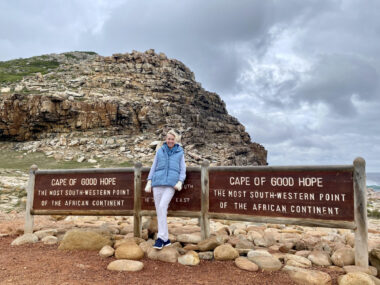Cape of Good Hope: A fitting destination for porphyria advocacy
A porphyria symposium in South Africa brings fellowship, knowledge, and hope
Written by |

As the mom of a 17-year-old son with erythropoietic protoporphyria and a staunch advocate for all porphyrias, I am blessed with some unexpected opportunities. These tend to happen in conjunction with international conferences organized to advance porphyria research and therapeutics.
A recent trip to South Africa for a porphyria conference offered a unique treat. The visit wasn’t complete without a trip to the Cape of Good Hope, especially for a gal who writes a column called “Hope in Action!”
The Cape is a historically significant and stunningly beautiful landmark at the southern tip of the Cape Peninsula, south of Cape Town. The turbulent water, the whipping wind, and the never-ending vista out to sea were incredible to experience. Baboons, ostriches, and hundreds of other bird species dotting the hilly landscape only added to the fairytale.

Kristen Wheeden takes in the wondrous sites at the Cape of Good Hope, South Africa in April. (Courtesy of Kristen Wheeden)
Though I felt blessed to enjoy this escape, my trip to South Africa held a deeper purpose.
As a member of the steering committee of the Unraveling Mysteries of Heme Metabolism International Symposium, which took place April 17-21, I traveled to support fundamental research in the porphyrias and to chair the “Patient Day” and “Porphyria Update” portions of the conference alongside the leader of the South African Porphyria Foundation (SAPF).
The mystery
The mysteries of heme metabolism were all too real in the biochemistry-heavy presentations. I feel confident that fundamental researchers are the smartest of all humans! These scientists present and discuss novel research that I struggle to retain. Don’t tell, but I often play a game of how long I can track with each speaker before they go beyond my capacity. Sometimes it’s only a few sentences into a talk.
The best is listening to discussions among researchers following presentations. They converse in what seems an entirely different language. I’m grateful for their mysterious language, though, as I believe these researchers will uncover obscure information about porphyrias that will lead to new therapeutics.
Patient Day
The Porphyria Patient Day was the first-ever in-person and livestream patient education meeting in South Africa. Given that SAPF is a newer organization, there has not been the opportunity to engage at this level even though there is an increased prevalence of porphyria patients in South Africa.
The emotion of patients connecting with one another — exchanging hugs, knowledge, and friendship — was soul-stirring. Especially while international experts educated attendees about disease diagnosis, management, and treatment.
Aletta Longari, the SAPF leader, offered a rousing call to action for the patient community to join together and for the researchers and clinicians to educate other healthcare professionals in South Africa.
If passion and commitment are a determinant of success, I spy a great future for the SAPF. They have global support as they continue to launch their foundation.
I ended this journey to South Africa with new friends, new knowledge, and a heightened passion to continue the work. I often say that if even one person is positively affected by an initiative that I participate in, it will have been worth it. That definitely was true during this conference. Science advanced and a community was strengthened.
I’m grateful for my visit to a new continent and the beautiful Cape of Good Hope. What an amazing place for hope to flourish into action!
Note: Porphyria News is strictly a news and information website about the disease. It does not provide medical advice, diagnosis, or treatment. This content is not intended to be a substitute for professional medical advice, diagnosis, or treatment. Always seek the advice of your physician or other qualified health provider with any questions you may have regarding a medical condition. Never disregard professional medical advice or delay in seeking it because of something you have read on this website. The opinions expressed in this column are not those of Porphyria News or its parent company, Bionews, and are intended to spark discussion about issues pertaining to porphyria.







Leave a comment
Fill in the required fields to post. Your email address will not be published.